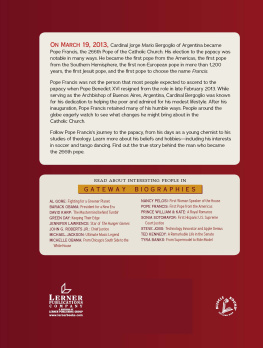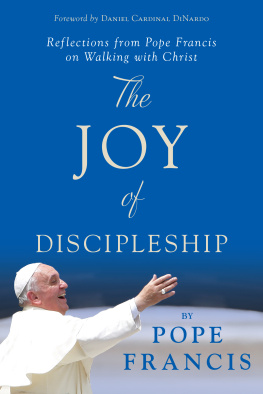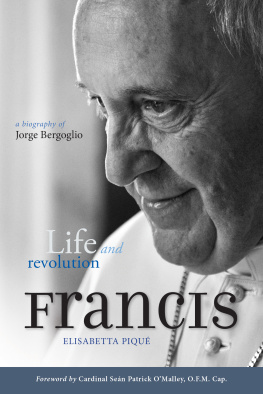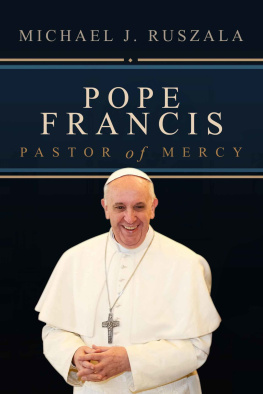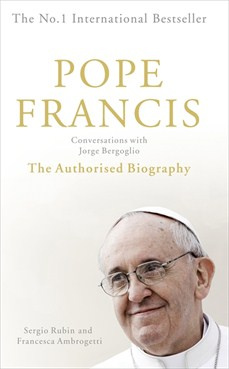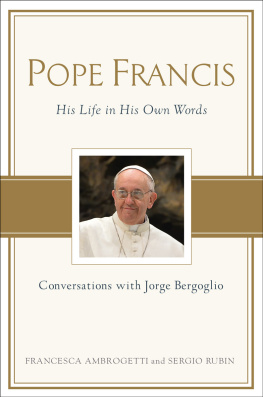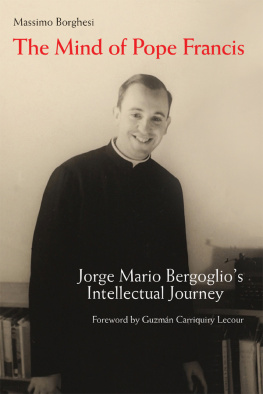Open Mind,
Faithful Heart
Reflections on Following Jesus
JORGE MARIO BERGOGLIO
POPE FRANCIS
Translated by
Joseph V. Owens, SJ


A Herder & Herder Book
The Crossroad Publishing Company
www.CrossroadPublishing.com
English translation copyright 2013 by The Crossroad Publishing Company
A Herder&Herder Book
The Crossroad Publishing Company, New York
Originally published as Mente abierta, corazon creyente.
Editorial Claretiana, Buenos Aires, Argentina
Chapter titles in the original Spanish publication have been altered in this English edition.
Scripture quotations are from the New Revised Standard Version Bible, copyright 1989 the Division of Christian Education of the National Council of the Churches of Christ in the United States of America.
Used by permission. All rights reserved.
All rights reserved. No part of this book may be reproduced, stored in a retrieval system, or transmitted, in any form or by any means, electronic, mechanical, photocopying, recording, or otherwise, without the written permission of The Crossroad Publishing Company. For permissions email
The stylized crossed letter C logo is a registered trademark of
The Crossroad Publishing Company.
ISBN 978-08245-1997-1 (alk. paper)
Library of Congress Cataloging-in-Publication Data
available from the Library of Congress.
Cover image: White Crucifixion, by Marc Chagall.
In the book El Jesuita, then Cardinal Bergoglio spoke of
White Crucifixion as his favorite painting.
Cover design by George Foster
Book design by The HK Scriptorium, Inc.
In continuation of our 200-year tradition of independent publishing, The Crossroad Publishing Company proudly offers a variety of books with strong, original voices and diverse perspectives. The viewpoints expressed in our books are not necessarily those of The Crossroad Publishing Company, any of its imprints or of its employees. No claims are made or responsibility assumed for any health or other benefit.
Books published by The Crossroad Publishing Company may be purchased at special quantity discount rates for classes and institutional use. For information, please e-mail .
Printed in the United States of America in 2013.
Contents
I n 2011, I was making one of my occasional visits to talk with my archbishop when he told me that he was gathering together all his writings and other papers. He wanted to have them in order since he would turn 75 in December and so present his resignation to the Pope according to canonical norms. He told me that to help him in this work he had secured the collaboration of Daniel Pellizzon, a young man who was then studying for a licentiate degree in theology at the Catholic University. The archbishop told me that he would contact me when all was in order so that I could evaluate the materials and see which might be worth publishing.
One thing that impressed me greatly was when Jorge (I always called him by his given name) told me, Make sure you know what youre doing. I dont want you to get nailedthats an expression meaning suffer economic loss. So it was with all the books of his that we published; he invariably repeated that warning to me. He even asked me if I needed help in order to publish the books. We should remember that during the first years of his ministry as the archbishop of Buenos Aires the country was immersed in a serious economic crisis and publishing books was not at all easy.
The editorial team of the Claretian Press went through his many writings and gradually put together various texts that we thought should be published. After we had assembled and edited each work, the final step was to send it to the cardinal so that he could give it his final revision and approval. We always reserved the right to give the book its title and an appropriate cover.
With regard to the publishing process, I share with you a little story that caused me some delight. After placing the book in the authors hands, we would anxiously await his reaction. The cardinal did not like to have his photo on the cover, but since we were the experts in publishing, we did not always pay him mind. Soon after receiving the copy of a new book, he would telephone me to offer his commentary. I remember one time we had put his photo very prominently on the cover, and Im not sure if he was really angry, but he certainly wasnt pleased. He told me several things, and all I could do was laugh. Finally, he thanked our press, and we bade each other a fraternal good-byehe with his unfailing, Pray for me, and have others pray for me.
It is important to stress that all of the books by him that we published were of decidedly pastoral orientation. They were never self-referential, to use one of his own terms. These materials were used by the author to reinforce and complement his pastoral ministry; they were written for all interested Christians, but especially for the pastoral workers of the archdiocese.
Among the large number of publications that have appeared in the months since the conclave, we do well to distinguish between books about the Pope and books of the Pope. Its not that some are better and some are worse, but these two types of books really differ in nature. The books about the Pope satisfy the urgent demand for information and background about the new pontiff, while the Popes own books, of which this is one, come directly from his own hand. For that reason, I think they will be long-lived. These are the books that show us all the depth and breadth of Francis, the new Pope. It is in these books that the author projects his inner self and makes himself visible in his own words.
Once he had finished putting order into Cardinal Bergoglios papers, Daniel met with me in the office of the Editorial Claretiana. He gave me the materials that he thought would be worth publishing so that our team could evaluate them. Once we had done that, he digitized those that were still only in manuscript form.
What can be said, then, with regard to this book, Open Mind, Faithful Heart? First and foremost, we must say that it is a book of spirituality. Let no one be deceived about that. It is written in a simple style using plain language that is accessible to the general public. It is the last book written by Bergoglio as cardinal, and it is the one that he liked best of all. As the bishop who wrote the prologue of the Spanish edition states, In this book is found the secret of Pope Francis.
There is no question about the quality of this work. Its texts are addressed to a wide audience, not only to priests and religious. Its forty-eight evocative meditations have an Ignatian flavor that will help the reader to draw closer to God and to others after the fashion of the Holy Fathers.
All that remains for me to do is to invite you to get first-hand knowledge of Pope Francis by reading his own writings.
Gustavo Larrazbal, CFM
W hen the editor asked me to write the prologue to this work by Cardinal Jorge Mario Bergoglio, I felt especially grateful. The request meant a lot to me, not only because I feel very close to the cardinal and highly esteem him, but also because it was a kind gesture toward me. Nevertheless, I tried to explain to the editor that I had many urgent things to attend to and would need some time before I could get around to writing the prologue. When he insisted, I ended up accepting the task, and Im not sorry I did.
As I began to read these pages, I could readily perceive that the work was the result of a long process of reflection, preaching, and spiritual retreats. The fruit of these experiences was now being presented in written form so as to help others in following Jesus Christ. I stress the aspect of personal witness, for the book really sums up many years of the cardinals life experience and his work as priest, pastor, and spiritual guide. We can discern in these pages the context of a spiritual retreat, or rather several retreats, in which these texts were slowly brought forth and carefully woven together. Even though these reflections arose in diverse times and circumstances, the work is not disjointed; it has a unity that flows both from the authors vision and, above all, from the person of Jesus Christ, the contemplation of whom is the focal point and source of life for Christian spirituality. What is noteworthy is the authors obvious concern to present Christian living as a reality oriented to improving our relations with God, with the world, and with one another. I especially appreciate the cardinals concrete, down-to-earth approach, which should serve us as a guide in the ways and practices of spirituality and as a basis for a sincere examination of conscience.
Next page
![Pope Francis [Jorge M Bergoglio] et al. Open Mind, Faithful Heart: Reflections on Following Jesus](/uploads/posts/book/106755/thumbs/pope-francis-jorge-m-bergoglio-et-al-open.jpg)


